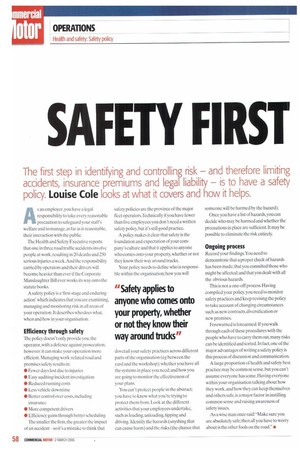SAFETY FIRST
Page 58

If you've noticed an error in this article please click here to report it so we can fix it.
The first step in identifying and controlling risk — and therefore limiting accidents, insurance premiums and legal liability — is to have a safety
policy. Louise Cole looks at what it covers and how it helps.
As an employer, you have a legal responsibility to take every reasonable precaution to safeguard your staffs welfare and to manage, as far as is reasonable, their interaction with the public.
The Health and Safety Executive reports that one in three road traffic accidents involve people at work, resulting in 20 deaths and 250 serious injuries a week. And the responsibility carried by operators and their drivers will become heavier than ever if the Corporate Manslaughter Bill ever works its way onto the statute books.
A safety policy is a 'first-stage and enduring action' which indicates that you are examining, managing and monitoring risk in all areas of your operation. It describes who does what, when and how in your organisation.
Efficiency through safety The policy doesn't only provide you. the operator, with a defence against prosecution, however: it can make your operation more efficient. Managing work-related road and premises safety results in: • Fewer days lost due to injuries • Easy auditing/incident investigation • Reduced running costs • Less vehicle downtime • Better control over costs, including insurance • More competent drivers • Efficiency gains through better scheduling The smaller the firm, the greater the impact of an accident —so it's a mistake to think that safety policies are the province of the major fleet operators. Technically if you have fewer than five employees you don't need a written safety policy, but it's still good practice.
A policy makes it clear that safety is the foundation and expectation of your company's culture and that it applies to anyone who comes onto your property, whether or not they know their way around trucks.
Your policy needs to define who is responsible within the organisation: how you will dovetail your safety practices across different parts of the organisation (eg between the yard and the workshop); whether you have all the systems in place you need; and how you are going to monitor the effectiveness of your plans.
You can't protect people in the abstract; you have to know what you're trying to protect them from. Look at the different activities that your employees undertake, such as loading, unloading,tipping and driving. Identify the hazards (anything that can cause harm) and the risks (the chance that someone will be harmed by the hazard).
Once you have a list of hazards, you can decide who may be harmed and whether the precautions in place are sufficient. It may be possible to eliminate the risk entirely.
Ongoing process Record your findings. You need to demonstrate that a proper check of hazards has been made; that you consulted those who might be affected; and that you dealt with all the obvious hazards.
This is not a one-off process. Having compiled your policy, you need to monitor safety practices and keep revising the policy to take account of changing circumstances such as new contracts,diversification or new premises.
Forewarned is forearmed. If you walk through each of these procedures with the people who have to carry them out,m any risks can be identified and sorted. In fact, one of the major advantages of writing a safety policy is this process of discussion and communication.
A large proportion of health and safety best practice may be common sense. but you can't assume everyone has some. Having everyone within your organisation talking about how they work, and how they can keep themselves and others safe, is a major factor in instilling common sense and raising awareness of safety issues.
As a wise man once said: "Make sure you are absolutely safe; then all you have to worry about is the other fools on the road." 2
















































































































































































































